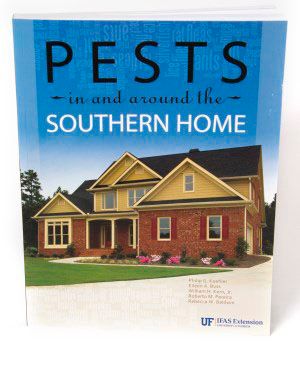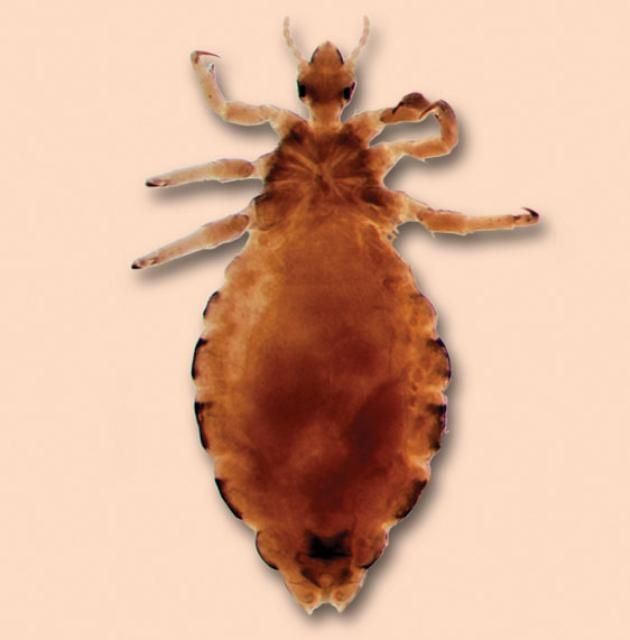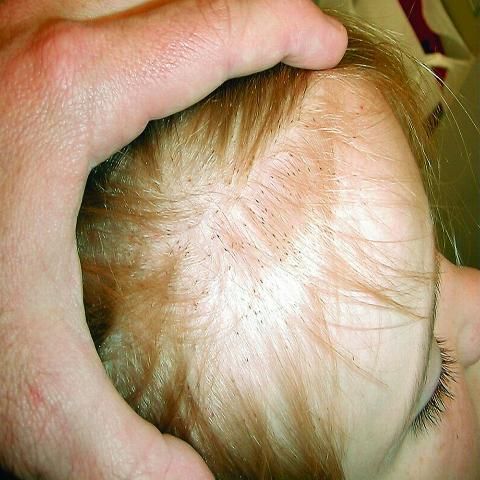
The human head louse (Figure 1) infests 10 million to 12 million people each year in the United States. Pediculosis, or "lousiness," is one of the most prevalent communicable conditions in this country. Lice are primarily transferred from person to person by direct contact or by several people using the same combs, brushes, hats, costumes, athletic equipment, towels, or bedding. Human head lice are not found on animals or household pets and are not transmitted from pets to humans. Because of children's play activity and close contact, head louse infestations are usually found on children, but can also spread to adults. The head louse is not considered to be a serious vector of disease in the United States, although severe infestations may cause irritation, scratching, and subsequent invasion of secondary infection from bacteria in louse feces. Itching from large numbers of bites may make the infested individual feel tired, irritable, and feverish, thus the term "feeling lousy."

Credit: James Castner, University of Florida
Biology
Lice have three pairs of legs, which makes them true insects. Lice do not have wings or powerful jumping legs, so they move about by clinging to hairs with clawlike legs. Head lice prefer to live on the hair of the head, although they have been known to wander to other parts of the body. Head lice feed every four to six hours; therefore, they must remain in close contact with the host. While a louse may fall onto other surfaces, they cannot survive off of humans for more than 24 hours. Therefore, they do not live for long within rugs, carpet, furniture, or school buses.
The eggs of lice are called nits. They are oval, tan, cylindrical, and 0.5–1.0 mm, or about 1/32 inch long. The eggs of head lice are usually glued to the base of hairs near the scalp (Figure 2). To protect the eggs from extremes in light and temperature, the female will commonly glue the eggs behind the ears and along the nape of the neck. Under normal conditions, the eggs will hatch in seven to 10 days. The newly hatched lice that escape from the egg must feed within a few hours or they will die. Immature lice will take blood meals and molt three times before becoming sexually mature adults. A newly hatched louse will mature in 10 to 12 days to an adult that is 1.8–3.3 mm, or about 1/8 inch in length.

A female louse can lay six to seven eggs (nits) per day. She may lay up to 140 eggs during her lifespan. Adults cannot survive more than about 24 hours without a blood meal. The nymphs and adults all have piercing-sucking mouthparts that pierce the skin for a blood meal.
The reaction of individuals to louse bites can vary considerably. Persons previously unexposed to lice experience little irritation from their first bite. After a short time, up to a few weeks, individuals may become sensitized to the bites and react with a general allergic reaction including reddening of the skin, itching, and overall inflammation. Subsequent infestations usually cause itching and redness within 24 to 48 hours. Some individuals never exhibit symptoms.
Prevention of Head Lice
Children should be encouraged not to share combs, hats, and other personal belongings. Daily washing and changing of clothes will also help prevent lice. However, head lice should not be solely associated with uncleanliness since they may be easily transferred from person to person. Sometimes head lice infestation can be traced back to children sharing equipment such as batting helmets or headphones. Periodic inspections will aid in early detection of individual lice, which are more easily controlled than advanced infestations where dozens of mature lice and possibly hundreds of nits are present. During the early fall months (August through November) children should be inspected weekly because "back-to-school" seems to be when lice are most commonly transmitted. This results in widespread infestations by December and January. September is National Head Lice Prevention Month.
Treatment of Head Lice
An integrated approach including preventative measures, inspection, manual louse and nit removal, cleaning the environment, and the careful use of pediculicides (lice killing agents) is the best approach to managing a head lice infestation. Note that there is no pediculicide product available that kills 100 percent of the louse eggs.
Best Inspection Practices
- Use good lighting during your inspection. A lamp or good natural light from a window will work well.
- Use a hand lens or magnifying glass (10x). Magnification may help detect nits and lice.
- Shampoo hair. If you are going to use a lice treatment product following your inspection and nit removal, do not use a product with conditioners in it. See product label for more specific details.
- Remove tangles with a comb or hairbrush.
- Divide the hair in sections, and fasten the hair that is not being examined.
- If lice or nits are discovered, all family members and other contacts (babysitters, cousins, playmates, teachers, etc.) should be inspected.
- Ideally, inspections and nit removal should be done daily for at least two weeks.
- Proceed to Best Nit Removal Practices Section.
If you are a health care professional screening many children for head lice, a magnifier lamp may be helpful. The magnifier and lamp are integrated into one unit. They can be purchased from suppliers of scientific equipment or office furniture, or from art and quilting supply stores. You will also want to use disposable gloves and wooden screening sticks to maintain proper hygiene from head to head.
Cleaning the Environment
Once an infestation is detected through inspection, all clothes should be washed in hot soapy water (150°F). Pillow cases, sheets, blankets and other bedding material should also be washed and placed in the clothes dryer on the "high heat" cycle for at least 20 minutes to kill the lice and their eggs. Carpets, furniture, car seats, and any nonwashable items such as children's toys should be thoroughly vacuumed and the vacuum bag immediately discarded outside of the home. Anything that cannot be vacuumed should be tightly sealed in plastic bags for at least seven to 10 days to kill all stages of lice.
Best Nit Removal Practices
- After removing tangles and dividing hair into manageable portions, use a louse comb to remove nits and lice. Using a regular comb will not remove nits. Removing nits is a tedious process requiring rigorous attention during which the hair is combed from root to tip with a special fine-toothed louse comb. Plastic combs are ineffective, so use metal louse combs.
- Dip comb in a container of hot soapy water to remove lice and nits.
- Look through that same section of hair for remaining nits and lice and repeat combing section, if necessary.
- Repeat all steps until all hair is systematically combed.
- Clean nit-removal comb, clips, brushes, and other tools with hot soapy water or, if using a metal comb, rubbing alcohol. An old toothbrush may help dislodge hair, nits, and lice that may be caught in the teeth of the comb. Plastic combs and toothbrush should be sealed in a plastic bag and discarded after use.
- Areas around the nit-combing area should be vacuumed, and the vacuum bag immediately discarded.
- Nit removal is key to controlling head lice because 20 to 80 percent of nits survive shampooing with pyrethrin- or permethrin-based products.
Nits are difficult to remove because they are glued onto the hair. There are several products available that claim to loosen nits. Many products are included in lice treatment kits. Data are not available to substantiate claims of effectiveness of many products.
RID products include an "egg and nit comb-out gel."
Clear Lice Elimination System also sells a "natural lice egg remover" in the form of a "vegetable-derived enzyme mousse."
Although difficult to wash out, alternative treatments using vegetable oil, mayonnaise, or petroleum jelly are also reported to make combing nits out easier.
Insecticidal Shampoos and Over-the-Counter Products
Insecticidal shampoos are available as over-the-counter (OTC) preparations at drugstores. Prescription products containing the active ingredients malathion and lindane are not recommended for use on children or adults. These products have had reported side effects. Most OTC products contain pyrethrins and permethrin.
When Treating Head Lice
- Do not use extra amounts of any lice medication unless instructed to do so by your physician and pharmacist. The drugs used to treat lice are insecticides and can be dangerous if they are misused or overused.
- Do not treat an infested person more than two to three times with the same medication if it does not seem to be working. This may be caused by using the medicine incorrectly or by resistance to the medicine. Always seek the advice of your health care provider if this should happen. He/she may recommend an alternative medication.
- Do not use different head lice drugs at the same time unless instructed to do so by your physician and pharmacist.
Apply lice medicine, also called pediculicide, according to the instructions contained in the box or printed on the label. If the infested person has very long hair (longer than shoulder length), it may be necessary to use a second bottle. Pay special attention to instructions on the label or in the box regarding how long the medication should be left on the hair and how it should be washed off.
WARNING: Do not use a creme rinse, combination shampoo/conditioner, or condition before using lice medicine. Do not rewash the hair for one to two days after the lice medicine is removed.
Suffocant Treatment as an Alternative
There is little scientific evidence to support the effectiveness of suffocant treatments, so we are not making a recommendation for their use. However, people turn to alternative treatments when they feel conventional treatments do not work, when they have toxicity concerns with conventional treatments, or they cannot afford conventional treatments. Suffocants such as oil, mayonnaise, or petroleum jelly have been applied to the hair in an effort to suffocate head lice. In general, suffocants are used by:
- Applying generously to the hair.
- Covering the hair with a shower cap for several hours. Do not use this method of covering the hair overnight, as it is a suffocation hazard to the person being treated.
- Shampooing hair to remove most of the suffocant.
- Removing nits and lice as discussed in Best Inspection Practices and Best Nit Removal Practices.
- Washing hair thoroughly with shampoo to remove remaining suffocant.
Frequently Asked Questions
- What's the difference between pyrethrins and permethrin?
Pyrethrins are naturally occurring compounds extracted from plants. Insects possess mechanisms to quickly break down pyrethrins. Therefore, the synergist piperonyl butoxide is usually added to the formulation to inhibit the insect's ability to break down the pyrethrins.
Permethrin is a synthetic based on the chemical structure of pyrethrins, but is much more effective. Permethrin has much longer residual activity and does not require the use of a synergist.
2. Can lice be transferred from my dog or cat to my children?
No. Head lice are specific to humans. They can only survive on a human host. If a head louse is removed from its host, it will generally die within a day.
3. How big are lice?
An adult head louse is approximately 2.5–3.5 mm, or 1/8 inch long. A louse egg, or "nit" is roughly 0.5-1.0 mm, or about 1/32 inch long.
4. I've heard that head lice are resistant to some of the lice treatments; is this true?
In some locations there have been reports of potential resistance to several different pediculicides. Experts are currently researching this issue and are trying to determine to what extent resistance exists. The best way to avoid this situation is to follow the directions on the product label closely. Improper application of pediculicides has significantly contributed to the presence of resistance in lice.
5. How long do lice live?
A louse egg hatches about 10 days after being glued to a hair shaft. Upon hatching, a louse will molt three times over a 10-to-12-day period before molting into a mature adult. An adult louse can live up to 40 days. Therefore, one louse can live about two months. However, most do not survive this long.
6. How long after my child contracts lice will I be able to detect them?
It only takes one adult female louse to begin an infestation. A female louse can lay several eggs each day. Within a couple of weeks a child may have dozens of immature lice living on his/her head. The more lice present, the more quickly the child will begin feeling an "itchy" scalp, which would usually lead to an inspection by a parent or school official. Looking for one louse or one nit might be difficult, but dozens should be readily apparent through close inspection.